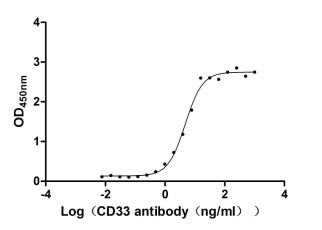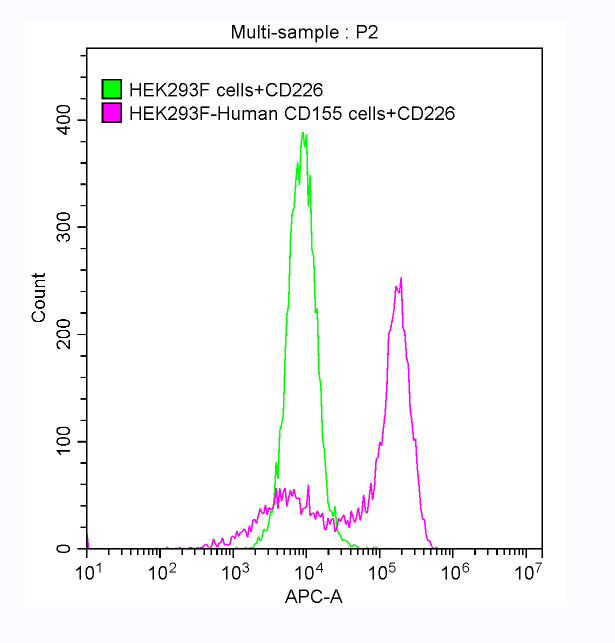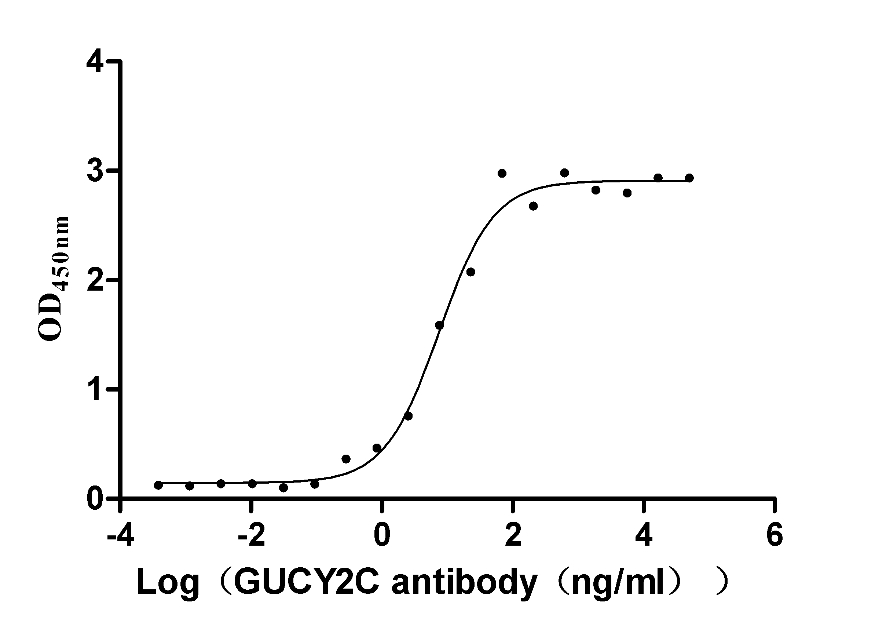Recombinant Human DNA repair protein RAD51 homolog 3 (RAD51C)
-
中文名称:人RAD51C重组蛋白
-
货号:CSB-YP019266HU
-
规格:
-
来源:Yeast
-
其他:
-
中文名称:人RAD51C重组蛋白
-
货号:CSB-EP019266HU
-
规格:
-
来源:E.coli
-
其他:
-
中文名称:人RAD51C重组蛋白
-
货号:CSB-EP019266HU-B
-
规格:
-
来源:E.coli
-
共轭:Avi-tag Biotinylated
E. coli biotin ligase (BirA) is highly specific in covalently attaching biotin to the 15 amino acid AviTag peptide. This recombinant protein was biotinylated in vivo by AviTag-BirA technology, which method is BriA catalyzes amide linkage between the biotin and the specific lysine of the AviTag.
-
其他:
-
中文名称:人RAD51C重组蛋白
-
货号:CSB-BP019266HU
-
规格:
-
来源:Baculovirus
-
其他:
-
中文名称:人RAD51C重组蛋白
-
货号:CSB-MP019266HU
-
规格:
-
来源:Mammalian cell
-
其他:
产品详情
-
纯度:>85% (SDS-PAGE)
-
基因名:RAD51C
-
Uniprot No.:
-
别名:BROVCA3; DNA repair protein RAD51 homolog 3; FANCO; MGC104277; R51H3; RA51C_HUMAN; Rad 51C; RAD51 homolog C (S. cerevisiae); Rad51 homolog c (S. cerevisiae), isoform CRA_b; RAD51 homolog C; RAD51 like protein 2; RAD51 paralog C; RAD51, S. cerevisiae, homolog of, C; RAD51-like protein 2; RAD51C; RAD51C protein; RAD51L2; RAD51L2/RAD51C protein ; RGD1563765; Yeast RAD51 homolog 3
-
种属:Homo sapiens (Human)
-
蛋白长度:Full length protein
-
表达区域:1-376
-
氨基酸序列MRGKTFRFEM QRDLVSFPLS PAVRVKLVSA GFQTAEELLE VKPSELSKEV GISKAEALET LQIIRRECLT NKPRYAGTSE SHKKCTALEL LEQEHTQGFI ITFCSALDDI LGGGVPLMKT TEICGAPGVG KTQLCMQLAV DVQIPECFGG VAGEAVFIDT EGSFMVDRVV DLATACIQHL QLIAEKHKGE EHRKALEDFT LDNILSHIYY FRCRDYTELL AQVYLLPDFL SEHSKVRLVI VDGIAFPFRH DLDDLSLRTR LLNGLAQQMI SLANNHRLAV ILTNQMTTKI DRNQALLVPA LGESWGHAAT IRLIFHWDRK QRLATLYKSP SQKECTVLFQ IKPQGFRDTV VTSACSLQTE GSLSTRKRSR DPEEEL
-
蛋白标签:Tag type will be determined during the manufacturing process.
The tag type will be determined during production process. If you have specified tag type, please tell us and we will develop the specified tag preferentially. -
产品提供形式:Lyophilized powder
Note: We will preferentially ship the format that we have in stock, however, if you have any special requirement for the format, please remark your requirement when placing the order, we will prepare according to your demand. -
复溶:We recommend that this vial be briefly centrifuged prior to opening to bring the contents to the bottom. Please reconstitute protein in deionized sterile water to a concentration of 0.1-1.0 mg/mL.We recommend to add 5-50% of glycerol (final concentration) and aliquot for long-term storage at -20℃/-80℃. Our default final concentration of glycerol is 50%. Customers could use it as reference.
-
储存条件:Store at -20°C/-80°C upon receipt, aliquoting is necessary for mutiple use. Avoid repeated freeze-thaw cycles.
-
保质期:The shelf life is related to many factors, storage state, buffer ingredients, storage temperature and the stability of the protein itself.
Generally, the shelf life of liquid form is 6 months at -20°C/-80°C. The shelf life of lyophilized form is 12 months at -20°C/-80°C. -
货期:Delivery time may differ from different purchasing way or location, please kindly consult your local distributors for specific delivery time.Note: All of our proteins are default shipped with normal blue ice packs, if you request to ship with dry ice, please communicate with us in advance and extra fees will be charged.
-
注意事项:Repeated freezing and thawing is not recommended. Store working aliquots at 4°C for up to one week.
-
Datasheet :Please contact us to get it.
相关产品
靶点详情
-
功能:Essential for the homologous recombination (HR) pathway of DNA repair. Involved in the homologous recombination repair (HRR) pathway of double-stranded DNA breaks arising during DNA replication or induced by DNA-damaging agents. Part of the RAD21 paralog protein complexes BCDX2 and CX3 which act at different stages of the BRCA1-BRCA2-dependent HR pathway. Upon DNA damage, BCDX2 seems to act downstream of BRCA2 recruitment and upstream of RAD51 recruitment; CX3 seems to act downstream of RAD51 recruitment; both complexes bind predominantly to the intersection of the four duplex arms of the Holliday junction (HJ) and to junction of replication forks. The BCDX2 complex was originally reported to bind single-stranded DNA, single-stranded gaps in duplex DNA and specifically to nicks in duplex DNA. The BCDX2 subcomplex RAD51B:RAD51C exhibits single-stranded DNA-dependent ATPase activity suggesting an involvement in early stages of the HR pathway. Involved in RAD51 foci formation in response to DNA damage suggesting an involvement in early stages of HR probably in the invasion step. Has an early function in DNA repair in facilitating phosphorylation of the checkpoint kinase CHEK2 and thereby transduction of the damage signal, leading to cell cycle arrest and HR activation. Participates in branch migration and HJ resolution and thus is important for processing HR intermediates late in the DNA repair process; the function may be linked to the CX3 complex. Part of a PALB2-scaffolded HR complex containing BRCA2 and which is thought to play a role in DNA repair by HR. Protects RAD51 from ubiquitin-mediated degradation that is enhanced following DNA damage. Plays a role in regulating mitochondrial DNA copy number under conditions of oxidative stress in the presence of RAD51 and XRCC3. Contributes to DNA cross-link resistance, sister chromatid cohesion and genomic stability. Involved in maintaining centrosome number in mitosis.
-
基因功能参考文献:
- results increase our knowledge about the RAD51C and RAD51D mutation spectrum and support the notion that these genes should be included in the gene panel testing performed on patients with hereditary breast and ovarian cancer syndrome PMID: 29409816
- The s assessed whether RAD51C promoter hypermethylation like mutation was associated with increased survival or increased sensitivity to platinum chemotherapy. However the results showed that neither outcomes were met PMID: 29233532
- novel splice-site mutations affect the last nucleotide of exon 2 (c.404G>C, c.404G>T) and disrupt proper RAD51C pre-mRNA processing. PMID: 27622768
- We showed that the mutation frequency of RAD51C in Japanese familial breast cancer cases was similar to that in Western countries and that the prevalence of deleterious mutation of PALB2 was possibly lower. Furthermore, our results suggested that BRIP1 mutation frequency in Japan might differ from that in Western countries PMID: 28796317
- Here we report yet another example of a rare RAD51C missense change (p.Arg312Trp) that impairs protein function. PMID: 28829762
- Using the human mammary epithelial cell line MCF10A, we show that deletion of TP53 can rescue RAD51C-deficient cells from radiation-induced cellular senescence, whereas it exacerbates their centrosome amplification and nuclear abnormalities PMID: 26820992
- Results identified a chromosomal translocation between Rad51C and Ataxin-7 in colorectal tumors. The in-frame fusion transcript results in a fusion protein with molecular weight of 110 KDa. In vitro 5-Azacytidine treatment of colorectal tumor cells showed expression of the fusion gene is regulated by promoter methylation. PMID: 27296891
- Germline mutation in RAD51C gene is associated with neoadjuvant therapy response in triple negative breast patients. PMID: 27328445
- Germline RAD51C mutation was found in patients with hereditary and sporadic gastric cancer. PMID: 28024868
- individuals with mutations in RAD51C that are exposed to estrogen would be more susceptible to accumulation of DNA damage, leading to cancer progression. PMID: 27753535
- Overexpression of RAD51C is associated with resistance to cisplatin and radiation in non-small cell lung cancer. PMID: 27465554
- RAD51C mutations were identified in 0.5 % of Danish families. PMID: 26740214
- RAD51C mutation is not associated with high-risk patients from Serbian hereditary breast/ovarian cancer. PMID: 26406419
- a mutation analysis in 171 high-risk BRCA1 and BRCA2 negative ovarian cancer patients, to evaluate the frequency of hereditary RAD51C and RAD51D variants in Czech population, is reported. PMID: 26057125
- Novel Rad51C splice variants occur in colorectal tumors and cells: Variant 1 without exon-7, Variant 2 without exon 6 and 7 , or Variant 3 without exon 7 and 8. They are associated with FANCD2 foci positive colorectal tumors and microsatellite stability. PMID: 25669972
- conclude that the woman has two potential disease-causing mutations and that predictive testing of family members should include both the RAD51C and BRCA2 mutation PMID: 25154786
- RAD51C and RAD51D are moderate ovarian cancer susceptibility genes. PMID: 26261251
- RAD51C mutation is associated with breast and ovarian cancer. PMID: 25086635
- The effect of common single nucleotide polymorphisms (SNPs) in non-coding regions of RAD51C in modulating the risk of breast cancer was investigated. PMID: 25343521
- Mutations in RAD51C are associated with drug resistance in breast cancer. PMID: 25292178
- the Rad51C promoter fragment can be used to transcriptionally target cancer cells. PMID: 24742710
- The findings suggest that RAD51C plays a marginal role in breast and ovarian cancer predisposition in Pakistan. PMID: 24800917
- three different cancer susceptibility and FA proteins function in a DNA repair pathway based upon the PALB2 WD40 domain binding to RAD51C and BRCA2. PMID: 24141787
- Paralogs of RAD51 might be candidates for genetic risk factors in sporadic squamous cell carcinomas of the head and neck. PMID: 24315737
- Single nucleotide polymorphisms in the Rad51C gene are strongly associated with increased risk for developing head and neck cancer. PMID: 24631219
- RAD51C-deficient cancer cells are highly sensitive to olaparib and offer preclinical proof-of-principle that RAD51C deficiency may be considered a biomarker for predicting the antitumor effects of olaparib. PMID: 23512992
- RAD51C is a susceptibility gene for ovarian and BC. PMID: 22725699
- Study observed centrosome defects in the absence of XRCC3. While RAD51B and RAD51C act early in homologous recombination, XRCC3 functions jointly with GEN1 later in the pathway at the stage of Holliday junction resolution. PMID: 23108668
- No RAD51C mutations c.837 + 1G > A or c.93delG were detected. PMID: 23176254
- This study concludes that germline mutations in RAD51C contribute marginally to breast and ovarian cancer susceptibility in ethnically diverse, Jewish high risk families. PMID: 23117857
- RAD51C mutations are rare events among high-risk breast cancer and breast/ovarian cancer families. PMID: 22476429
- We propose that analogous to germline genetic mutations constitutive epimutations in BRCA1 and RAD51C may serve as the first hit of tumor development. PMID: 22843497
- study detected 1.3 percent mutations of RAD51C in breast and ovarian cancer families, while mutations in breast cancer only families seem to be very rare PMID: 22451500
- the contribution of RAD51C and RAD51D gene mutations to an inherited high risk of ovarian cancer is very small PMID: 22752287
- RAD51C germline mutations in families with a history for both breast and ovarian cancer appear to have a low prevalence with the exception of some founder mutations. PMID: 22370629
- Missense variant of RAD51C (p.Gly264Ser) is a moderate penetrance allele in high-risk breast and ovarian cancer families. PMID: 21990120
- unravel the critical role of RAD51C in the FA pathway of ICL repair and as a tumor suppressor. PMID: 22167183
- RAD51C mutations are implicated in breast and ovarian cancer predisposition. PMID: 21750962
- RAD51C is a rare breast and ovarian cancer susceptibility gene. PMID: 21980511
- PALB2 mutations are present in a small but substantial proportion of inherited breast cancer cases, and indicates that RAD51C at a population level does not account for a substantial number of familial breast cancer cases PMID: 21409391
- These results suggest RAD51C as the first moderate-to-high risk susceptibility gene for ovarian cancer. PMID: 21616938
- Data show there was no deleterious RAD51C mutation among the 454 familial breast/ovarian cancer patients. PMID: 20723205
- Unable to confirm the contribution of the RAD51C gene to hereditary breast and ovarian cancer. PMID: 20697805
- Reports show RAD51C is a cancer susceptibility gene associated with increased risk of Fanconi anemia-like disorder, breast and ovarian cancer.[Review] PMID: 20952512
- biallelic germline mutations in a RAD51 paralog are associated with an FA-like syndrome [case report] PMID: 20400963
- Germline mutations in breast and ovarian cancer pedigrees establish RAD51C as a human cancer susceptibility gene PMID: 20400964
- This work describes the in vitro and in vivo identification of the RAD51B/RAD51C heterocomplex PMID: 11744692
- Rad51B and Rad51C function through interactions with the human Rad51 recombinase and play a crucial role in the homologous recombinational repair pathway PMID: 12427746
- analysis of protein domains important for functioning of RAD51L2; there is a specific requirement for RAD51L2 in gene conversion in mammalian cells PMID: 12966089
- a fragment of Rad51B containing amino acid residues 1-75 interacts with the C-terminus and linker of Rad51C, residues 79-376, and this region of Rad51C also interacts with mRad51D and Xrcc3 PMID: 14704354
显示更多
收起更多
-
相关疾病:Fanconi anemia complementation group O (FANCO); Breast-ovarian cancer, familial, 3 (BROVCA3)
-
亚细胞定位:Nucleus. Cytoplasm. Cytoplasm, perinuclear region. Mitochondrion. Note=DNA damage induces an increase in nuclear levels. Accumulates in DNA damage induced nuclear foci or RAD51C foci which is formed during the S or G2 phase of cell cycle. Accumulation at DNA lesions requires the presence of NBN/NBS1, ATM and RPA.
-
蛋白家族:RecA family, RAD51 subfamily
-
组织特异性:Expressed in a variety of tissues, with highest expression in testis, heart muscle, spleen and prostate.
-
数据库链接:
HGNC: 9820
OMIM: 602774
KEGG: hsa:5889
STRING: 9606.ENSP00000336701
UniGene: Hs.412587
Most popular with customers
-
Recombinant Human Myeloid cell surface antigen CD33 (CD33), partial (Active)
Express system: Mammalian cell
Species: Homo sapiens (Human)
-
Recombinant Human Transthyretin (TTR) (Active)
Express system: Mammalian cell
Species: Homo sapiens (Human)
-
Recombinant Human CD226 antigen (CD226), partial (Active)
Express system: Mammalian cell
Species: Homo sapiens (Human)
-
Recombinant Human Heat-stable enterotoxin receptor (GUCY2C), partial (Active)
Express system: Mammalian cell
Species: Homo sapiens (Human)
-
Recombinant Rat Microtubule-associated protein tau (Mapt) (Active)
Express system: Mammalian cell
Species: Rattus norvegicus (Rat)
-
Recombinant Human Trophoblast glycoprotein (TPBG), partial (Active)
Express system: Mammalian cell
Species: Homo sapiens (Human)
-
Recombinant Human Dickkopf-related protein 1 (DKK1) (Active)
Express system: Mammalian cell
Species: Homo sapiens (Human)
-
Recombinant Human C-C chemokine receptor type 8 (CCR8)-VLPs (Active)
Express system: Mammalian cell
Species: Homo sapiens (Human)








-AC1.jpg)











